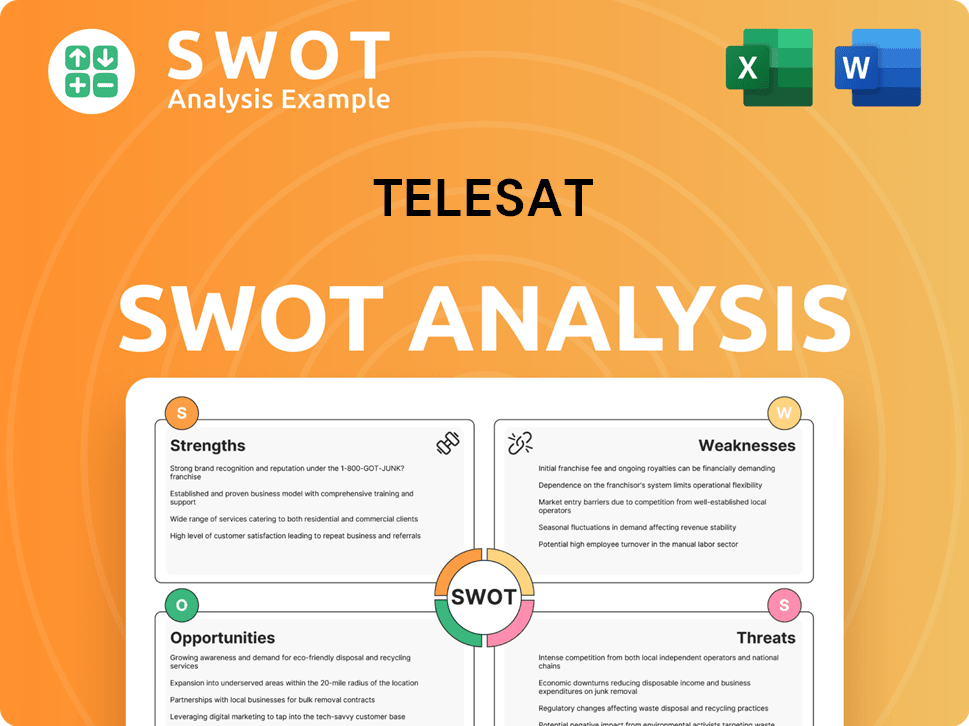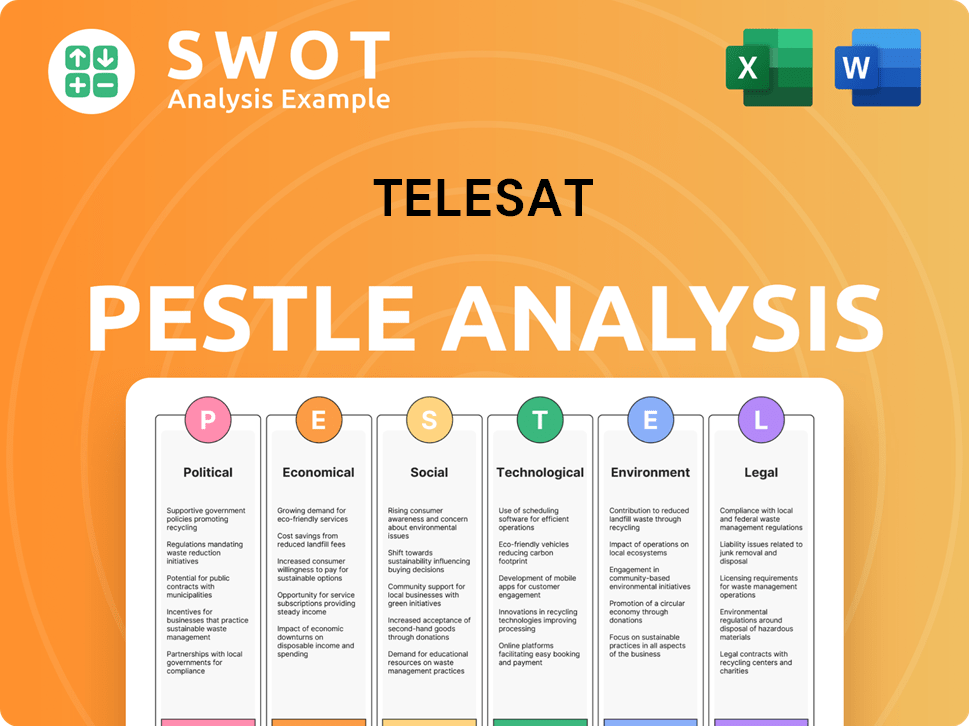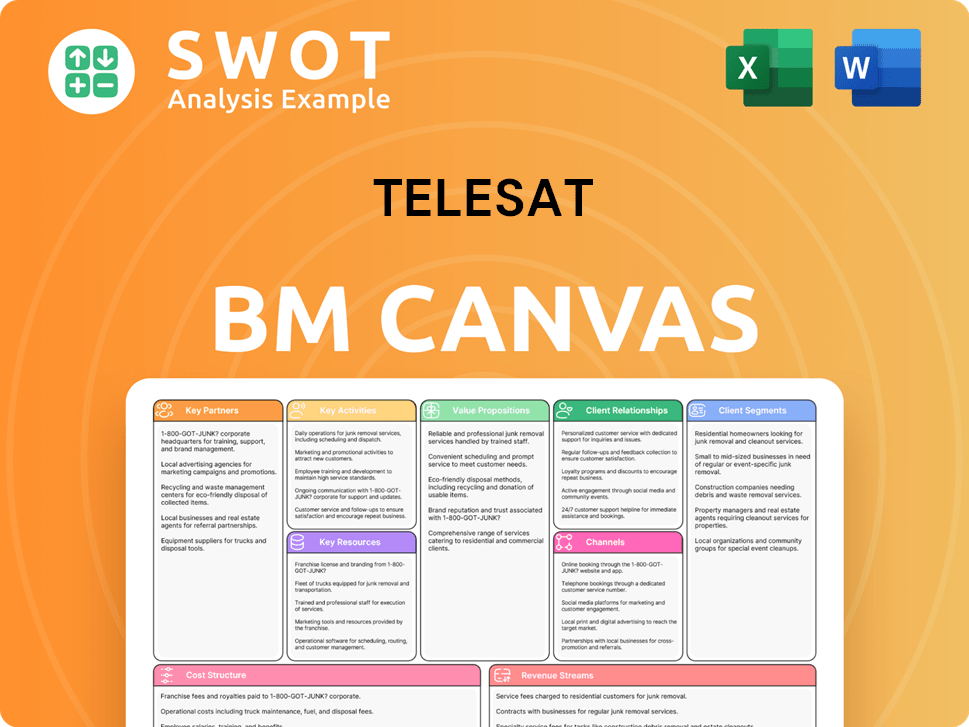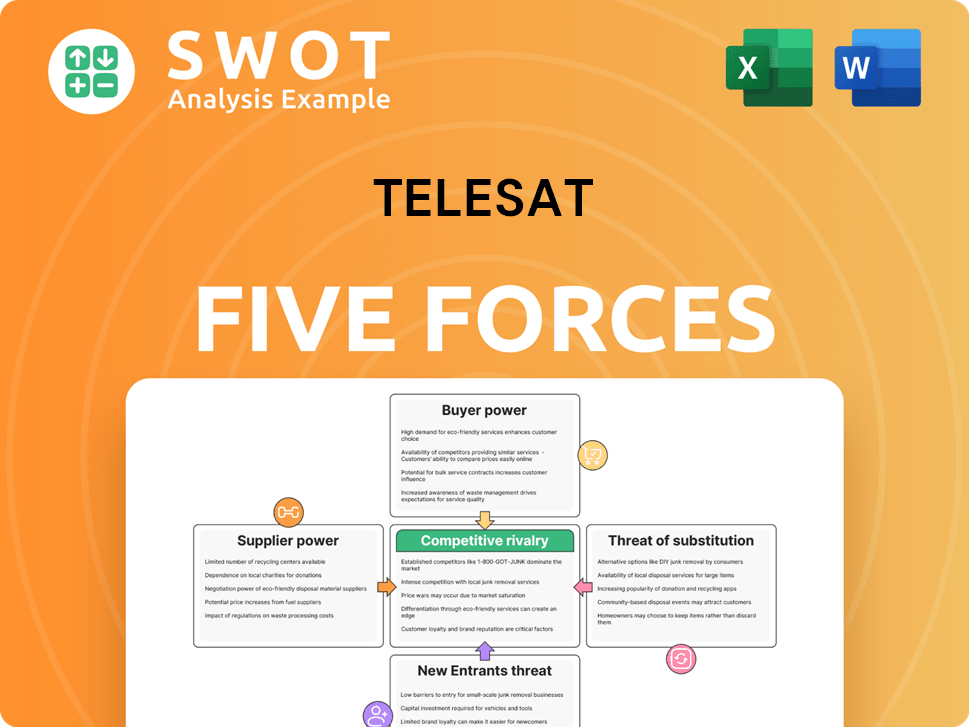Telesat Bundle
Can Telesat Revolutionize Satellite Communications?
Telesat, a veteran in the satellite communications sector, is making a bold move with its ambitious Telesat Lightspeed project. This strategic shift to a Low Earth Orbit (LEO) satellite constellation signals a major transformation for the company. Founded in 1969, Telesat has a rich history, evolving from providing essential connectivity across Canada to becoming a global leader in satellite services.

This exploration will delve into Telesat's Telesat SWOT Analysis, examining its innovative approach to space-based internet and its plans for future growth. The company's success hinges on its ability to execute its LEO strategy and navigate the competitive landscape of the satellite communications industry. Understanding Telesat's Telesat growth strategy and Telesat future prospects is key to assessing its potential in the evolving market, including its Telesat company business model and its impact on rural connectivity.
How Is Telesat Expanding Its Reach?
The primary expansion strategy for Telesat, a key player in the satellite communications sector, centers around the deployment of its Telesat Lightspeed LEO (Low Earth Orbit) satellite constellation. This initiative is designed to significantly broaden its service offerings and market reach, aiming to provide fiber-like broadband connectivity globally. This expansion is a critical part of the Telesat growth strategy, positioning the company to meet the increasing demand for high-throughput, low-latency connectivity.
The Lightspeed constellation targets several key markets, including enterprise, government, and mobility sectors. The Telesat future prospects are heavily reliant on the successful deployment and operation of this constellation. The company anticipates that the initial services from Lightspeed will commence in 2027, marking a significant milestone in its expansion journey. This strategic move is driven by the growing need for reliable and secure communications, especially in underserved and remote areas.
Beyond the technical aspects, Telesat is actively expanding its partnerships and diversifying its customer base. The company has secured substantial funding and agreements to support the Lightspeed project, demonstrating strong confidence in its Telesat company vision. These financial commitments are crucial for the development and deployment of the constellation, which requires a considerable capital investment.
The Lightspeed constellation, a critical component of Telesat's expansion, is designed to offer global, high-speed internet access. This initiative is a core element of Telesat's strategy to compete in the satellite communications market. The deployment involves a significant investment and strategic partnerships to ensure its successful launch and operation.
Telesat is actively working to broaden its customer base across various sectors. This includes securing contracts with government entities and forging alliances with terrestrial network operators. The focus is on providing tailored solutions to meet the specific connectivity needs of each customer segment, driving Telesat's market share growth.
Strategic alliances are crucial for Telesat's expansion plans, particularly in extending the reach and integration of its satellite services. These partnerships involve collaborations with terrestrial network operators and service providers. This approach allows Telesat to leverage existing infrastructure and expertise, enhancing its service delivery capabilities.
Telesat has secured significant financial backing to support its expansion initiatives. This includes substantial contributions from government entities and private investors. These investments are vital for funding the Lightspeed project and ensuring the company's long-term growth and success in the competitive space-based internet market.
Telesat has secured significant funding and agreements to support the Lightspeed project, including a $2.1 billion contribution from the Canadian government, a $400 million investment from the provincial government of Quebec, and a $200 million contribution from Telesat itself. These investments are crucial for the development and deployment of the constellation, which involves a total capital expenditure of approximately $5 billion.
- The Canadian government has committed $1.6 billion over a 10-year period to provide high-speed internet to rural and remote areas through the Lightspeed constellation, connecting approximately 40,000 households and businesses.
- These financial commitments underscore the confidence in Telesat's ability to deliver advanced satellite services.
- These initiatives are designed to connect approximately 40,000 households and businesses.
- For more insights into the competitive landscape, consider reading about the Competitors Landscape of Telesat.
Telesat SWOT Analysis
- Complete SWOT Breakdown
- Fully Customizable
- Editable in Excel & Word
- Professional Formatting
- Investor-Ready Format

How Does Telesat Invest in Innovation?
The core of the Telesat growth strategy revolves around its significant investment in the Telesat Lightspeed LEO (Low Earth Orbit) constellation. This initiative marks a substantial advancement in satellite communication technology, aiming to provide high-speed, low-latency internet services globally. The company's future prospects are closely tied to the successful deployment and operation of this advanced satellite network.
Telesat's technology roadmap is focused on creating a software-defined network capable of dynamic traffic routing and performance optimization. This involves the development of sophisticated phased-array antennas, advanced onboard processing capabilities, and a robust ground segment infrastructure. The goal is to offer unprecedented levels of throughput and low latency, rivaling terrestrial fiber networks.
The company is also exploring the integration of AI and machine learning for network optimization, predictive maintenance, and enhanced cybersecurity. Telesat's digital transformation strategy is evident in its efforts to automate network operations and provide flexible, on-demand services to its customers. While specific patents or industry awards related to Lightspeed are still emerging as the project progresses, the sheer scale and technological ambition of the constellation position Telesat as a leader in next-generation satellite innovation.
Telesat Lightspeed is a LEO constellation designed to offer high-speed, low-latency broadband services. The target latency is between 30-50 milliseconds, comparable to fiber networks.
Telesat is leveraging advanced beamforming, network virtualization, and cloud-based operations to enhance the capabilities of its Lightspeed network. The company is also exploring the integration of AI and machine learning.
A key differentiator for Telesat is its focus on a software-defined network. This architecture allows for dynamic traffic management and optimization, enhancing network efficiency and responsiveness.
Telesat is committed to building a highly resilient and secure network architecture. This is crucial in the rapidly evolving satellite communications market, ensuring reliable service delivery.
The company's approach to digital transformation is evident in its efforts to automate network operations and provide flexible, on-demand services to its customers. This includes the use of cloud-based solutions.
Telesat's R&D efforts are focused on creating a highly advanced, software-defined network that can dynamically route traffic and optimize performance. This includes developing sophisticated phased-array antennas.
Telesat's innovation strategy centers on several key technological advancements designed to enhance the performance and capabilities of its Lightspeed constellation. These innovations are critical to the company's long-term success and its ability to compete in the satellite communications market. For a deeper dive into Telesat's business model, you can refer to this article on Telesat's business model analysis.
- Advanced Beamforming: This technology allows the satellites to direct signals with precision, increasing bandwidth and reducing interference.
- Network Virtualization: This enables the creation of a flexible and scalable network infrastructure, allowing for efficient resource allocation and service customization.
- AI and Machine Learning: Integration of AI and machine learning for network optimization, predictive maintenance, and enhanced cybersecurity.
- Cloud-Based Operations: Utilizing cloud-based solutions for network management and service delivery, providing flexibility and scalability.
Telesat PESTLE Analysis
- Covers All 6 PESTLE Categories
- No Research Needed – Save Hours of Work
- Built by Experts, Trusted by Consultants
- Instant Download, Ready to Use
- 100% Editable, Fully Customizable

What Is Telesat’s Growth Forecast?
The financial outlook for the Telesat company is largely dependent on the successful deployment and commercialization of its Lightspeed constellation. This ambitious project is designed to generate substantial revenue growth, with initial services expected to commence in 2027. The company's future prospects are closely tied to its ability to execute its strategic plans and capture a significant share of the growing market for space-based internet services.
Telesat's financial strategy involves a combination of funding sources, including government support, equity investments, and debt financing, to support the Lightspeed project. The company's financial performance in recent quarters reflects the ongoing transition and investment phase for the Lightspeed project, which is a key element of its Telesat growth strategy. The company is aiming to establish Lightspeed as a leading global broadband network.
As of the three months ended March 31, 2024, Telesat reported revenue of CAD 178 million, a decrease from CAD 185 million for the same period in 2023. The adjusted EBITDA for the same period was CAD 129 million, down from CAD 140 million in the prior year. These figures highlight the current phase of investment and transition as Telesat positions itself for future growth. The company's long-term goals are centered around maximizing shareholder value through technological leadership and market expansion, as detailed in Mission, Vision & Core Values of Telesat.
Telesat anticipates a significant increase in revenue as the Lightspeed constellation becomes fully operational. This growth will be driven by increased customer adoption and the expansion of services. The company is focused on securing long-term contracts with enterprise, government, and mobility customers to ensure a stable revenue stream.
The company's financial strategy includes a mix of funding sources to support the Lightspeed project. This includes government funding, equity investments, and debt financing. The company's approach to managing its capital structure will be critical to its long-term success and its ability to navigate the competitive landscape.
The initial investment in Lightspeed is substantial, but the long-term financial goals are supported by the anticipated demand for high-speed, low-latency satellite broadband services. The company expects the constellation to generate significant returns on its approximately $5 billion capital expenditure. This is a key factor in evaluating Telesat's investment opportunities.
Telesat's expansion plans include a strategic shift from its traditional GEO satellite business to a more growth-oriented LEO model. This shift is designed to capitalize on the growing demand for space-based internet and to increase Telesat's market share. The focus is on maximizing shareholder value through technological leadership and market expansion.
Telesat's financial performance is closely monitored through several key metrics. These metrics include revenue, EBITDA, and capital expenditures related to the Lightspeed project. Understanding these metrics is essential for assessing Telesat's financial performance and its potential challenges.
- Revenue: Reflects the total income generated from services.
- EBITDA: Indicates the company's operational profitability.
- Capital Expenditure: Represents investments in the Lightspeed constellation.
- Customer Base: The size and composition of the customer base.
Telesat Business Model Canvas
- Complete 9-Block Business Model Canvas
- Effortlessly Communicate Your Business Strategy
- Investor-Ready BMC Format
- 100% Editable and Customizable
- Clear and Structured Layout

What Risks Could Slow Telesat’s Growth?
The path to realizing the Telesat growth strategy, particularly with its Lightspeed constellation, is fraught with potential risks and obstacles. These challenges span market competition, regulatory hurdles, supply chain vulnerabilities, and the inherent uncertainties of technological advancement. Navigating these complexities requires a robust risk management framework and strategic foresight.
One of the primary concerns for Telesat's future prospects is the intense competition within the satellite communications industry. Established players and emerging ventures are vying for market share in the space-based internet sector. This competitive landscape could impact the company's ability to secure customers and achieve its financial objectives.
Furthermore, the substantial capital expenditure required for the Lightspeed project, estimated at approximately $5 billion, introduces significant financial risk. Any cost overruns or delays in securing additional funding could strain Telesat's financial resources, potentially affecting its expansion plans and long-term goals.
Telesat's faces stiff competition from established players like Starlink and OneWeb, which are already deploying LEO satellites. This competitive environment could pressure pricing and limit market share, affecting Telesat's market share and revenue projections. The success of Telesat's expansion plans hinges on its ability to differentiate its services and capture a significant portion of the market.
Changes in spectrum allocation and licensing for LEO constellations pose a risk. Unfavorable regulations could delay deployments or increase operational costs, impacting Telesat's technology roadmap. The regulatory environment plays a crucial role in determining the feasibility and profitability of Telesat's low Earth orbit constellation.
Disruptions in the global supply chain for satellite components and launch services present another vulnerability. Delays or shortages could impact the Lightspeed deployment timeline and budget. Mitigating these risks requires diversified supplier bases and robust contingency plans.
Rapid technological advancements by competitors could undermine Lightspeed's competitive advantage. Failure to fully realize the technical capabilities of the constellation could hinder its success. Continuous innovation and adaptation are essential to maintain a leading position in the space-based internet market.
The substantial capital expenditure of around $5 billion for Lightspeed creates financial risk. Cost overruns or delays in securing additional funding could strain Telesat's resources. Careful financial management and strategic partnerships are crucial for mitigating these challenges.
Operational challenges, including launch failures and in-orbit malfunctions, pose risks. These events could disrupt service and increase costs. Telesat's ability to manage these risks will impact its long-term goals, requiring strong operational expertise and insurance coverage.
Telesat employs proactive measures to mitigate these risks. These include diversifying its supplier base to address supply chain vulnerabilities and establishing long-term agreements. The company has also secured significant government funding and formed strategic partnerships to de-risk the financial aspects of the Lightspeed project. These partnerships are key to navigating the challenges of the competitive landscape.
A thorough competitive analysis is crucial. The company must continually assess the strengths and weaknesses of its competitors, such as Starlink and OneWeb. Understanding their strategies and market positioning allows Telesat to refine its own approach and maintain a competitive edge. For more information on the company's strategies, check out this article: Marketing Strategy of Telesat.
Telesat Porter's Five Forces Analysis
- Covers All 5 Competitive Forces in Detail
- Structured for Consultants, Students, and Founders
- 100% Editable in Microsoft Word & Excel
- Instant Digital Download – Use Immediately
- Compatible with Mac & PC – Fully Unlocked

Related Blogs
- What are Mission Vision & Core Values of Telesat Company?
- What is Competitive Landscape of Telesat Company?
- How Does Telesat Company Work?
- What is Sales and Marketing Strategy of Telesat Company?
- What is Brief History of Telesat Company?
- Who Owns Telesat Company?
- What is Customer Demographics and Target Market of Telesat Company?
Disclaimer
All information, articles, and product details provided on this website are for general informational and educational purposes only. We do not claim any ownership over, nor do we intend to infringe upon, any trademarks, copyrights, logos, brand names, or other intellectual property mentioned or depicted on this site. Such intellectual property remains the property of its respective owners, and any references here are made solely for identification or informational purposes, without implying any affiliation, endorsement, or partnership.
We make no representations or warranties, express or implied, regarding the accuracy, completeness, or suitability of any content or products presented. Nothing on this website should be construed as legal, tax, investment, financial, medical, or other professional advice. In addition, no part of this site—including articles or product references—constitutes a solicitation, recommendation, endorsement, advertisement, or offer to buy or sell any securities, franchises, or other financial instruments, particularly in jurisdictions where such activity would be unlawful.
All content is of a general nature and may not address the specific circumstances of any individual or entity. It is not a substitute for professional advice or services. Any actions you take based on the information provided here are strictly at your own risk. You accept full responsibility for any decisions or outcomes arising from your use of this website and agree to release us from any liability in connection with your use of, or reliance upon, the content or products found herein.